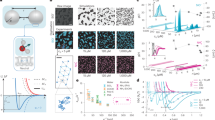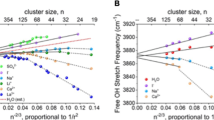Abstract
Molecular dynamics simulations have previously described how the physical properties across immiscible liquid–liquid interfaces should converge from aqueous to organic limits1,2,3,4,5, but these predictions have largely gone untested, owing to difficulties associated with probing buried interfaces. X-ray and neutron scattering experiments have created detailed pictures of molecular structure at these boundaries6,7,8, but such scattering studies cannot probe how surface-altered solvent structures affect interfacial solvating properties. Given that surface-mediated solvent properties control interfacial solute concentrations and reactivities, identifying the characteristic dimensions of interfacial solvation is essential for formulating predictive models of solution phase surface chemistry. Here we use specially synthesized solvatochromic surfactants that act as ‘molecular rulers’9 and resonance-enhanced second-harmonic generation10,11,12,13 to measure the dipolar width of weakly and strongly associating liquid–liquid interfaces. Dipolar width describes the distance required for a dielectric environment to change from one phase to another. Our results show that polarity converges to a nonpolar limit on subnanometre length scales across a water–cyclohexane interface. However, polarity across the strongly associating, water–1-octanol interface is dominated by a nonpolar, alkane-like region. These data call into question the use of continuum descriptions of liquids to characterize interfacial solvation, and demonstrate that interfacial environments can vary in a non-additive manner from bulk solution limits.
This is a preview of subscription content, access via your institution
Access options
Subscribe to this journal
Receive 51 print issues and online access
$199.00 per year
only $3.90 per issue
Buy this article
- Purchase on Springer Link
- Instant access to full article PDF
Prices may be subject to local taxes which are calculated during checkout



Similar content being viewed by others
References
Viceli, J. & Benjamin, I. Adsoprtion at the interface between water and self-assembled monolayers: Structure and electronic spectra. J. Phys. Chem. B 106, 7898–7907 (2002)
Chang, T. M. & Dang, L. X. Molecular dynamics simulations of CCl4-H2O liquid-liquid interface with polarizable potential models. J. Chem. Phys. 104, 6772–6783 (1996)
Chipot, C., Wilson, M. A. & Pohorille, A. Interactions of anesthetics with the water-hexane interface. A molecular dynamics study. J. Phys. Chem. B 101, 782–791 (1997)
DaRocha, S. R. & Rossky, P. J. Surfactant modified CO2-water interface: A molecular view. J. Phys. Chem. B 106, 13250–13261 (2002)
Senapati, S. & Berkowitz, M. L. Computer simulation study of the interface width of the liquid/liquid interface. Phys. Rev. Lett. 87, 176101 (2001)
Lee, L. T., Langevin, D. & Farnoux, B. Neutron reflectivity at liquid interfaces. Physica B 198, 83–88 (1994)
Penfold, J., Richardson, R. M., Zarbakhsh, A. & Webster, J. R. P. Recent advances in the study of chemical surfaces and interfaces by specular neutron reflection. J. Chem. Soc. Faraday Trans. 93, 3899–3917 (1997)
Tikhonov, A. M., Mitrinovic, D. M., Li, M., Huang, Z. & Schlossman, M. L. An X-ray reflectivity study of the water-docosane interface. J. Phys. Chem. B 104, 6336–6339 (2000)
Steel, W. H., Damkaci, F., Nolan, R. & Walker, R. A. Molecular rulers: New families of molecules for measuring interfacial widths. J. Am. Chem. Soc. 124, 4824–4831 (2002)
Antoine, A., Bianchi, F., Brevet, P. F. & Girault, H. H. Studies of water/alcohol and air/alcohol interfaces by second harmonic generation. J. Chem. Soc. Faraday Trans. 93, 3833–3838 (1997)
Corn, R. M. & Higgins, D. A. Optical second harmonic spectroscopy as a probe of surface chemistry. Chem. Rev. 94, 107–125 (1994)
Eisenthal, K. B. Photochemistry and photophysics of liquid interfaces by second harmonic spectroscopy. J. Phys. Chem. 100, 12997–13006 (1996)
Zhuang, X., Miranda, P. B., Kim, D. & Shen, Y. R. Mapping molecular orientation and conformation at interfaces by surface nonlinear optics. Phys. Rev. B 59, 12632–12640 (1999)
Laurence, C., Nicolet, P. & Dalati, M. T. The empirical treatment of solvent-solute interactions: 15 years of π*. J. Phys. Chem. 98, 5807–5816 (1994)
Shen, Y. R. Surface properties probed by second harmonic and sum frequency generation. Nature 337, 519–525 (1989)
Wang, H., Borguet, E. & Eisenthal, K. B. Polarity of liquid interfaces by second harmonic generation spectroscopy. J. Phys. Chem. A 101, 713–718 (1997)
Wang, H., Borguet, E. & Eisenthal, K. B. Generalized interface polarity scale based on second harmonic spectroscopy. J. Phys. Chem. B 102, 4927–4932 (1998)
Ishizaka, S., Kim, H. B. & Kitamura, N. Time-resolved total internal reflection fluorometry study on polarity at a liquid/liquid interface. Anal. Chem. 73, 2421–2428 (2001)
Benjamin, I. Solvent effects on electronic spectra at liquid interfaces. A continuum electrostatic model. J. Phys. Chem. A 102, 9500–9506 (1998)
Steel, W. H. & Walker, R. A. Solvent polarity at an aqueous/alkane interface: The effect of solute identity. J. Am. Chem. Soc. 125, 1132–1133 (2003)
Li, Z. X., Bain, C. D., Thomas, R. K., Duffy, D. C. & Penfold, J. Monolayers of hexadecyltrimethylammonium p-tosylate at the air-water interface 2. Neutron reflection. J. Phys. Chem. B 102, 9473–9480 (1998)
Penfold, J. & Thomas, R. K. Solvent distribution in non-ionic surfactant monolayers. Phys. Chem. Chem. Phys. 4, 2648–2652 (2002)
Tikhonov, A. M. & Schlossman, M. L. Surfactant and water ordering in triacontanol monolayers at the water-hexane interface. J. Phys. Chem. B 107, 3344–3347 (2003)
Schweighofer, K., Essmann, U. & Berkowitz, M. Simulation of sodium dodecyl sulfate at the water-vapor and water-carbon tetrachloride interfaces at low surface coverages. J. Phys. Chem. B 101, 3793–3799 (1997)
Zhang, X. & Walker, R. A. Discrete partitioning of solvent permittivity at liquid-solid interfaces. Langmuir 17, 4486–4489 (2001)
Zhang, Z., Mitrinovic, D. M., Williams, S. M., Huang, Z. & Schlossman, M. L. X-ray scattering from monolayers of F(CF2)10(CH2)2OH at the water-(hexane solution) and water-vapor interfaces. J. Chem. Phys. 110, 7421–7432 (1999)
Barton, A. F. M. (ed.) IUPAC Solubility Data Series: Alcohols with Water (Pergamon, Oxford, 1984)
Tsonopoulos, C. & Wilson, G. M. High-temperature mutual solubilities of hydrocarbons and water. Am. Inst. Chem. J. 31, 376–384 (1983)
Sangster, J. Octanol-Water Partition Coefficients (ed. Fogg, P. G. T.) 2–15 (Wiley and Sons, New York, 1997)
Acknowledgements
This work was supported by the Research Corporation and the National Science Foundation through its CAREER Program.
Author information
Authors and Affiliations
Corresponding author
Ethics declarations
Competing interests
The authors declare that they have no competing financial interests.
Rights and permissions
About this article
Cite this article
Steel, W., Walker, R. Measuring dipolar width across liquid–liquid interfaces with ‘molecular rulers’. Nature 424, 296–299 (2003). https://doi.org/10.1038/nature01791
Received:
Accepted:
Issue Date:
DOI: https://doi.org/10.1038/nature01791
This article is cited by
-
Faster chemistry at surfaces
Nature Chemistry (2021)
-
Liquids relax and unify strain in graphene
Nature Communications (2020)
-
Molecular reactions at aqueous interfaces
Nature Reviews Chemistry (2020)
-
Probing non-polarizable liquid/liquid interfaces using scanning ion conductance microscopy
Science China Chemistry (2020)
-
Electrochemical and optical study of the confined aqueous layer adsorbed on gold electrodes cycled in phosphate and dodecylsulphate solutions
Journal of Applied Electrochemistry (2014)
Comments
By submitting a comment you agree to abide by our Terms and Community Guidelines. If you find something abusive or that does not comply with our terms or guidelines please flag it as inappropriate.



